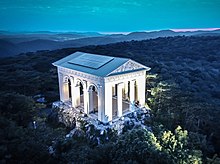Hussar temple
The Hussar Temple is a classicist building on the Kleiner Anninger ( 496 m above sea level ) in the Föhrenberge Nature Park in the municipality of Mödling . The temple is one of the many artificial ruins that were built around Liechtenstein Castle , the seat of the Liechtenstein family at the time.
history
The original building was constructed in wood between 1809 and 1811 on behalf of Prince Johann I Josef von Liechtenstein by the architect Joseph Hardtmuth . The cleared mountain slopes were reforested with the umbrella pine typical of the area . The building was completely destroyed in a storm in 1812.
Today's massive successor building was built in 1813 by Joseph Kornhäusel as the "Temple of War Glory" . It is dedicated to the fallen in the battle of Aspern . The tombs inside contain the bodies of five soldiers from that battle. They are still treated as graves of honor by the city of Mödling today .
The family history of the monument is likely to have prompted Crown Prince Rudolf in 1888 to first consider the hussar temple as the site of his suicide .
Excursion destination
The temple can be seen from afar from the Vienna Basin. That is why in 1999, in addition to the renovation by the city of Mödling, the electricity supplier Wien-Energie installed lighting for the temple in a joint project with HTL Mödling , which is powered by solar energy .
literature
- Walter Ulreich (Hrsg.): The "Hussar Temple" - actually temple on the Anninger, temple of war glory, also Temple of Minerva or long-time rehabilitation of the English travel writer Frances Trollope . A persistent Biedermeier legend and its prehistory, Föhrenhof Mödling, November 24 to December 31, 1996, brochure accompanying the exhibition . Edition Bicycle Archive Ulreich, Hinterbrühl 1996, ISBN 3-901470-02-6 .
- Hermann Dikowitsch (Red.): The Vienna Woods . Preservation of monuments in Lower Austria, Volume 22. Office of the Lower Austrian Provincial Government, Department of Culture and Science, St. Pölten 1999.
- From the high summit of the mountain - greet a proud building there - a noble prince gratefully created this - German courage and German loyalty. R. Wild before 1900
Individual evidence
- ↑ a b Dikowitsch: Wienerwald , p. 52.
- ↑ Until the unveiling of the Lion of Aspern , 1858, the Husarentempel was until then the only official memorial to the Austrian victory over Napoleon I remembered. - Stefan Riesenfellner (Ed.): Steinernes Consciousness I - the public representation of state and national identity of Austria in its monuments . Böhlau, Vienna 1998, ISBN 3-205-98797-7 , p. 336, online , accessed on October 3, 2010.
- ^ Anton Rieder: The Vienna Woods. Nature, history and culture in a unique landscape . Brandstätter, Vienna 2002, ISBN 3-85498-215-1 .
- ^ Karl Baedeker: Austria, South and West Germany. Guide for travelers . 13th, revised edition. Baedeker, Coblenz 1868, p. 31 f., Online , accessed on October 3, 2010.
- ↑ Permalink Austrian Library Association .
- ↑ PDF online ( Memento of the original from January 9, 2016 in the Internet Archive ) Info: The archive link was inserted automatically and has not yet been checked. Please check the original and archive link according to the instructions and then remove this notice. , accessed October 3, 2010.
Web links
- Hussar temple . In: anninger.heim.at , accessed on October 3, 2010.
- 17 Hussar Temple (...) In: Fritz Peterka: Walks around Vienna. 50 selected day hikes in Vienna, the Vienna Woods and the Weinviertel (the most beautiful valley and mountain hikes) . 6th edition. Rother hiking guide. Rother, Munich 2006, ISBN 3-7633-4188-9 , p. 54 f.
Coordinates: 48 ° 4 ′ 37 ″ N , 16 ° 15 ′ 6 ″ E


